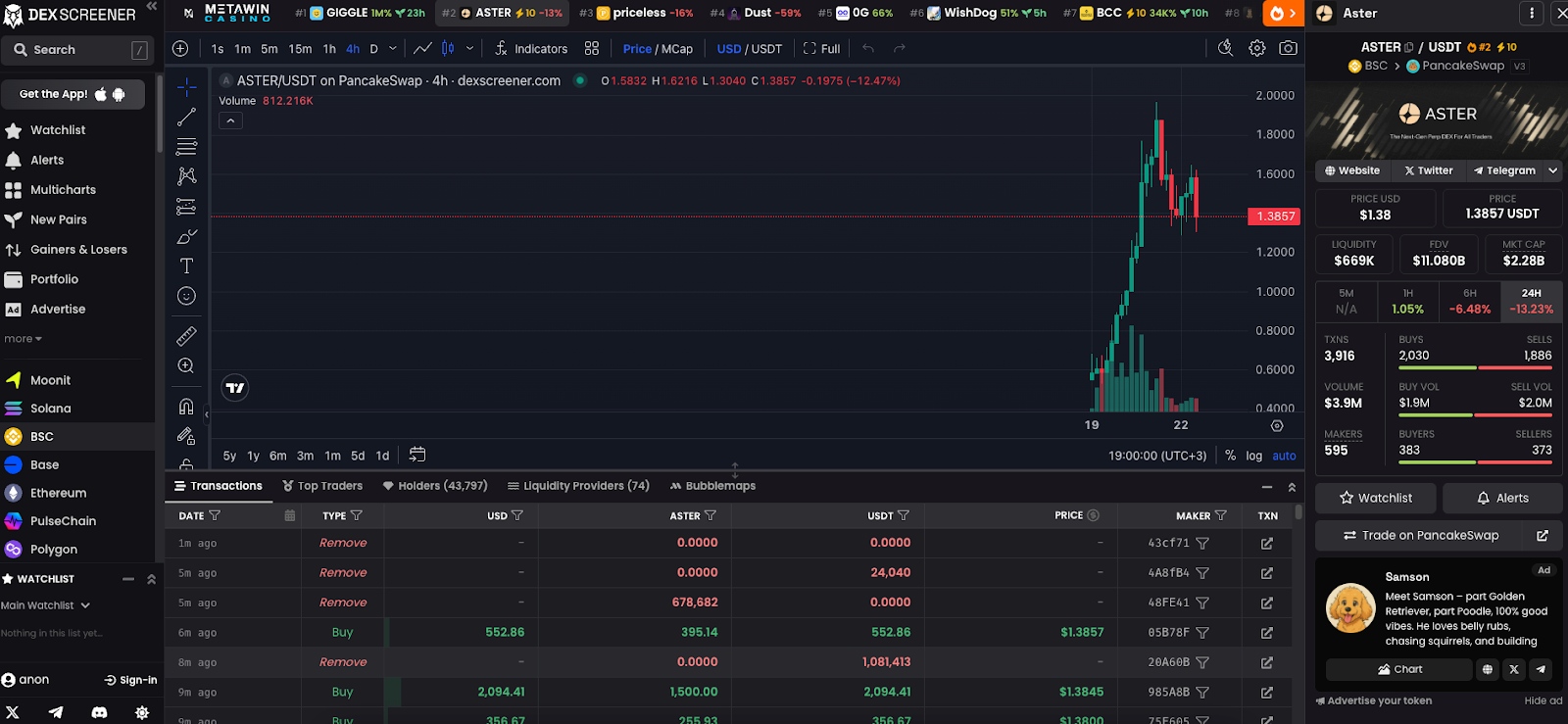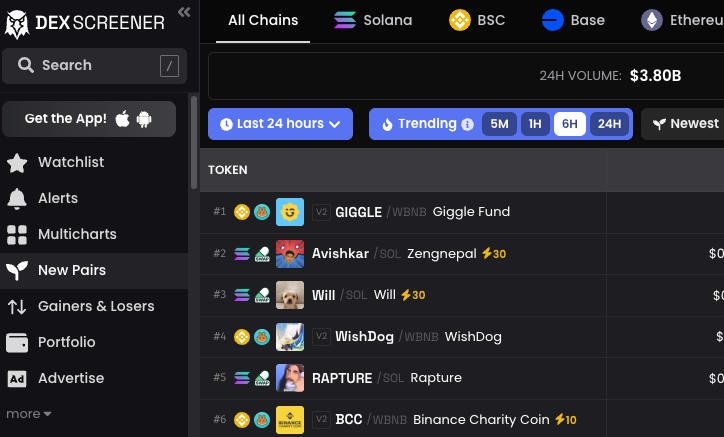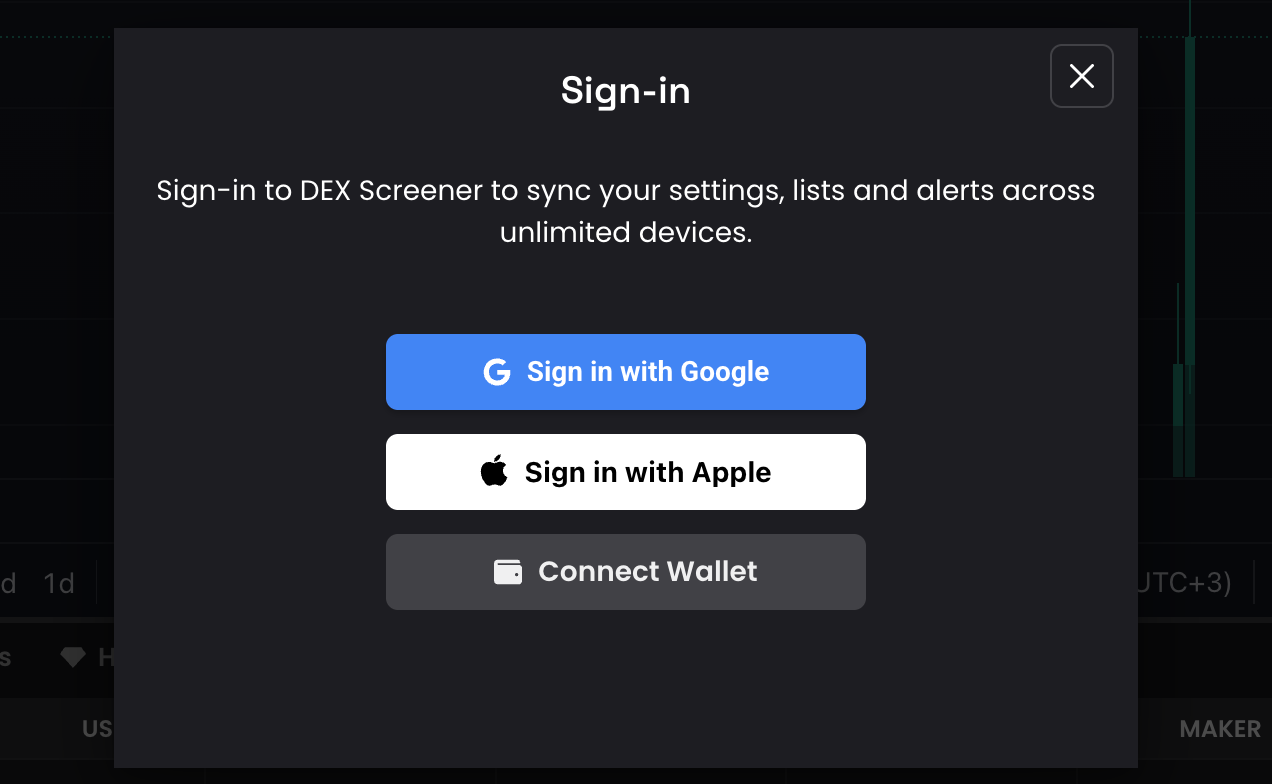Operating in DeFi without immediate market data is a critical failure. Professional traders rely on real-time token tracking and on-chain insights to make informed decisions. DEX Screener has become one of the most essential DeFi tools for this purpose, offering a powerful, free lens into the decentralized market. It allows you to monitor liquidity across countless exchanges and networks, identify new opportunities, and refine your crypto trading strategy. This guide focuses on leveraging its key features to move beyond basic trading and toward a more data-driven, analytical approach.
What is DEX Screener and How Does It Work?
The simplest way to understand DEX Screener is to think of it as the Bloomberg Terminal for decentralized finance. It's a real-time DeFi scanner that plugs directly into the source: the blockchain networks themselves. This is its key advantage. Its critical advantage is data integrity. Instead of relying on third-party APIs that can lag, it pulls information directly from the blockchains themselves. You get a raw, unfiltered view of on-chain activity as it happens. For any professional, that kind of direct sourcing is non-negotiable.
This raw data feed powers an incredibly broad and fast interface. We can track thousands of trading pairs across every relevant network from Ethereum L2s to Solana all in one place. It’s not just about watching prices; it’s about analyzing the underlying liquidity to gauge market depth and setting precise price alerts to monitor specific assets. DEX Screener's real power is in providing transparency into the underlying market mechanics. By indexing the raw data, it lets you analyze a token based on actual on-chain trading volume and holder activity. It’s the difference between speculation and data-driven analysis.

DEX Screener Key Features</h2>
What sets it apart is how much it surfaces in one place: token performance, liquidity shifts, volume spikes, and live market sentiment across multiple chains.
Its value lies in how cleanly it delivers that information. Whether you’re setting price alerts, watching fresh listings, or cross-referencing trades with technical indicators, DEX Screener keeps everything real-time and right in front of you. It’s a browser-based dashboard, but it feels like a terminal built for DeFi.
For anyone trading outside of centralized exchanges, this platform fills the gap between raw blockchain data and actionable market insight.
DEX Screener Key Features
DEX Screener is a popular tool among crypto traders, analysts, and DeFi enthusiasts for its advanced charting tools, liquidity tracking, market analysis, and historical data, which help traders make informed decisions about established cryptocurrencies and emerging projects.
- Real-time Data: The platform delivers up-to-the-minute data on token prices, trading volumes, liquidity, and market capitalization across various blockchain networks.
- Advanced Charting Tools: DEX Screener uses TradingView charts, allowing users to apply technical indicators such as moving averages (MA), relative strength index (RSI), and Bollinger Bands. These tools help users identify potential price trends, significant market movements, and trading opportunities.
- Liquidity Tracking: Traders can monitor the liquidity levels of specific token pairs across different DEXs, ensuring they can execute trades with minimal slippage.
- Custom Alerts: Users can set up custom alerts based on specific tokens, price levels, or trading volumes. These alerts notify traders of significant market changes, enabling them to act quickly.
- New Pair Listings: The platform highlights the latest token pairs listed on various DEXs, allowing traders to get in early on promising projects.
- API Access for Developers: DEX Screener provides an API that developers can integrate into their own applications, facilitating real-time data access and monitoring.
- Cross-Chain Support: The platform supports a vast array of blockchain networks, allowing users to track tokens and pairs across multiple chains.
DEX Screener Key Components
DEX Screener has lots of essential components that help you analyze data comprehensively. Lets review them below.
Trends Section
The Trends section functions as a real-time market scanner, designed to answer one question: where is the capital and attention flowing right now?

Its power isn't just in showing what's active, but in its filtering capabilities. A trader can isolate specific chains or narrow the timeframe down to the last five minutes to spot immediate breakouts. This is how you cut through the market noise to see which assets have genuine momentum.
This section's primary function is signal generation for short-term and momentum-driven strategies. Its design is entirely focused on identifying the inception of a trend or reacting to sharp bursts of volatility.
DEX Screener Chart
The charting interface is built around one core, powerful feature: its multi-chart layout. The ability to monitor a grid of up to 16 tokens simultaneously is invaluable for cross-market analysis. This is what is used to track correlations between assets or monitor multiple setups at once without constantly switching tabs.

The platform uses a TradingView-powered engine, so the experience is familiar and reliable. You have the essential tools for basic technical analysis right there. This includes standard timeframes, a clean candlestupid chart view, and the key momentum indicators you'd expect, like moving averages and RSI. It is not a replacement for a dedicated, high-end charting suite, but it provides more than enough for rapid, on-the-fly analysis.
Its primary role is not complex, multi-indicator strategies. Instead, it’s designed for speed and clarity. The goal is to provide a clean, responsive environment where a trader can quickly assess price action across the market and make an informed decision, prioritizing function over an exhaustive feature list.
New Pairs Section
The New Pairs section is where discovery begins. This part of DEX Screener lists fresh token pairings added to decentralized exchanges often within minutes of launch. For traders hunting early entries or monitoring newly deployed contracts, it’s a goldmine.

Each new listing comes with key metrics: initial price, launch time, early trading volume, liquidity, and fully diluted valuation (FDV). You can filter results by network, age, or liquidity threshold to focus on projects that meet your risk profile, whether you're watching for meme coin breakouts or researching more structured launches.
This section helps you get ahead of the curve, not just track it. It’s especially valuable for those following launchpad tokens, stealth drops, or fast-moving communities on chains like Solana, BNB Chain, or Base.
Price Alerts
Price alerts are a tool for systematic trade execution, not just passive monitoring. Their function is to automate your watchlists and free you from having to constantly stare at the charts. For any professional, this is a matter of operational efficiency.

The application is straightforward. You define your strategy as an entry point on a dip, an exit at a specific profit level, or a breakout alert for a new token and you let the system do the watching. You can use them extensively to monitor dozens of pairs across multiple chains simultaneously. It is impossible to do that manually with any degree of precision.
For anyone juggling multiple pairs or moving across chains, price alerts become a lightweight but essential part of managing risk and catching opportunities early.
Gainers & Losers Section
For traders watching short-term price action, the Gainers & Losers section is a fast way to see where the momentum is both good and bad. This dashboard highlights the tokens that have surged or dumped the hardest over a selected time frame, letting you filter by trading volume, liquidity, chain, or fully diluted valuation (FDV).

It’s particularly useful for spotting volatility early. A token that’s suddenly gaining 300% volume or dropping 25% in an hour tells you something’s happening. whether it’s a catalyst, hype cycle, or smart money exit.
You can sort data by time range (15 minutes to 24 hours), token age, or liquidity level to refine your signal and focus only on the moves that matter. It’s a practical, high-level scanner for active traders trying to catch waves or avoid traps.
DEX Screener API
DEX Screener offers an API for developers or advanced traders who want to build custom tools or integrate data into their existing applications. The API allows users to gather data on networks, token pairs, and trading activity. By leveraging this API, you can automate data retrieval, conduct in-depth analysis, or enhance your trading algorithms.
Moonshot DEX Screener
Moonshot is one of DEX Screener’s more experimental features and one of the most interesting if you're into launching or tracking low-cap tokens. Built specifically for the Solana ecosystem, Moonshot lets users create and list tokens directly through the platform. It’s fast, permissionless, and aimed at developers or communities that want to test, launch, or meme without going through a full token deployment flow.

Users can submit basic details like a token ticker, description, and social links. Once live, the token appears on Solana-based DEXs like Raydium or Meteora, where it’s tradeable by anyone. If the market cap hits a specific threshold currently 432 SOL, it graduates to broader visibility within the Screener interface.
It’s a lightweight launchpad baked into the DEX Screener experience. Whether you’re building something real or just testing the waters, Moonshot gives you a runway.
Is DEX Screener Safe?
The platform's safety model is simple: it doesn't ask for anything. You don't connect a wallet. You don't sign in. You don't give it any personal data to use the service. This isn't a feature; it's a fundamental design choice that eliminates the primary user-side attack vectors. Your assets and your identity are never exposed to the platform.
The second security question is about data integrity. Is the information it shows trustworthy? The answer here lies in its architecture. DEX Screener runs its own indexers that read raw transaction data directly from the blockchains. It is not relying on external APIs that could be compromised or serve delayed information. You are viewing a direct representation of on-chain activity.
This minimalist approach extends to privacy. Because no personal data is required for use, the platform inherently respects user privacy. In an environment of increasing data regulation worldwide, a tool that provides high-level analytics without demanding user data is a rarity and a significant professional advantage.
Still, safety in DeFi goes beyond platform design. Like any public tool, DEX Screener isn’t immune to market manipulation especially around low-liquidity tokens or new pair listings. It gives you the data, but it doesn’t vet the projects you’re analyzing. That’s up to the trader.
So yes, DEX Screener is safe to use. But as with everything in crypto, the real risk lies in what you do with the information it gives you.
Why Use DEX Screener?
The primary function of DEX Screener is to solve the problem of market fragmentation. That's its purpose. In DeFi, trading activity is scattered across dozens of blockchains and hundreds of individual exchanges.
This tool aggregates that fragmented data into a single, real-time interface. You are not hunting for information on multiple block explorers or trusting third-party aggregators. You have a direct, on-chain view of token prices, liquidity, and volume across the entire market.
The fact that this level of data is provided for free, without a paywall or token gate, is a notable strategic choice that has made it a foundational part of the public infrastructure for DeFi. For any serious, data-driven trading operation in 2025, it's not just a useful tool; it is the essential starting point for market analysis.
- Comprehensive Data: With access to over 5,000 tokens and 80+ blockchain networks, DEX Screener offers unparalleled coverage of the DeFi market.
- User-Friendly Interface: The platform is designed to be intuitive, making it accessible to both beginner and advanced traders. The customization options allow users to focus on the data that matters most.
- Real-Time Updates: In the fast-paced world of cryptocurrency, having access to real-time data is critical. DEX Screeners ability to deliver timely and accurate information gives traders a competitive edge.
- Free Access: Unlike other trading platforms requiring subscriptions or token holdings, DEX Screener is entirely free to use. This makes it an attractive option for traders who dont want to commit to premium services.
How to Buy and Sell Tokens via DEXScreener
DEXScreener functions as an efficient front-end for executing trades. It is not an exchange itself, but a routing layer that connects your analysis directly to the underlying DEX. This workflow streamlines the process from discovery to execution.
1. Select a Pair
Use the search bar or browse trending pairs to locate the specific token you wish to analyze and trade.
2. Connect Your Wallet
From the chart view, click the “Trade” button. This will initiate a secure prompt to connect your Web3 wallet.

3. Select the Amount
With your wallet connected, input the amount of the token you want to swap. The interface will fetch a real-time price quote.

4. Confirm the Transaction
Before approving in your wallet, verify all critical parameters: slippage tolerance, gas fees, and the final token output amount.
How to Use DEX Screener for Technical Analysis
Effective technical analysis in DeFi requires a tool that is both broad and fast. DEX Screener’s workflow begins with its powerful filters, allowing a trader to screen for tokens by chain, trading volume, or liquidity. This is the first step to cutting through market noise.
Once a pair is selected, the platform offers a clean, TradingView-powered interface for chart analysis. The candlestick charts are responsive, and it provides a solid suite of essential technical indicators, like Moving Averages and RSI to analyze price movements and gauge momentum. Its most significant feature for a professional workflow, however, is the multi-chart layout, monitoring up to 16 charts at once is critical for tracking sector-wide trends.
While it lacks the advanced scripting of dedicated software, its strength is providing rapid, functional analysis directly at the point of discovery.
How to Use DEX Screener for Fundamental Analysis
Fundamental analysis in DeFi is not about traditional financials; it's about assessing a project's on-chain health and legitimacy. DEX Screener provides the essential, real-time data for this initial vetting process.
For any token, the key metrics are displayed prominently: total liquidity, the market cap, and the fully diluted valuation (FDV). The relationship between these numbers is the first thing we check. A massive FDV paired with thin liquidity is a classic red flag, often indicating a project is built on hype rather than genuine capital. You can also track the number of unique holders and the transaction log to gauge distribution and market interest.
The platform also provides direct links to the project's official website and smart contract on a block explorer. This is not a substitute for a comprehensive due diligence process, which would include a deep dive into the whitepaper and contract audits. However, DEX Screener is an indispensable first step. It provides the high-level, on-chain data needed to quickly validate or disqualify a project before committing more time to a deeper investigation.
DexTools vs. DEX Screener
The choice between DexTools and DEX Screener comes down to a fundamental difference in philosophy: depth versus breadth. They are both essential tools, but they solve different problems.
DexTools is built for deep, granular analysis of a single asset. It excels at providing layered data like individual wallet tracking, detailed holder analysis, and various community trust scores. It's the right tool for intensive due diligence on a specific project.
DEX Screener is optimized for breadth and speed. Its strength is providing a high-level, real-time view of the entire market across dozens of chains. You can use it as a market-wide scanner to spot emerging trends and monitor correlations. It's about fast, efficient market awareness.
A professional workflow often involves both. You use DEX Screener to scan the market and identify a potential opportunity. You then pivot to DexTools to conduct a deeper investigation of that specific asset.

- Ease of Use: DEX Screener is known for its user-friendly interface, making it ideal for traders who prioritize simplicity. DexTools, on the other hand, offers more advanced features, such as wallet tracking and a "Trust Score" for assessing project credibility.
- Features: Both platforms provide real-time data and charting tools, but DexTools takes it a step further by offering features like wallet tracking and atomic swaps. However, DEX Screener shines in its ability to track new token pairs and its free access to price alerts.
- Cost: DEX Screener is completely free to use, whereas DexTools offers some premium features only to users who hold its native DEXT tokens.
Other DEX Screener Alternatives
Choosing the right tool ultimately depends on your trading style, focus chain, and how deep you want to go with analysis.
DexTools is perhaps the most established alternative, and its strength lies in depth. Traders looking to conduct comprehensive due diligence on a single token will find tools like wallet tracking, holder breakdowns, and social sentiment scoring far more detailed than what DEX Screener currently provides. It’s especially valuable for swing traders and researchers building conviction over time.
GeckoTerminal, built by the team behind CoinGecko, takes the opposite approach: breadth over depth. It now supports more than 170 blockchain networks, giving traders a clean, simple view of liquidity, price, and volume across nearly the entire DeFi space. While its charting isn’t as robust, it’s unmatched for broad, cross-chain scanning.
Birdeye has become a go-to scanner for Solana-native traders, but its support for Ethereum, Base, and Arbitrum has expanded its reach. It’s fast, mobile-friendly, and excels at surfacing new listings and trending tokens in near real time. If you're focused on getting in early or simply tracking Solana-based pairs, Birdeye offers one of the best experiences in the space.
Other rising tools in 2025 include:
- De.Fi’s Scanner: Offers on-chain security scoring, rug checks, and risk analytics with AI-generated safety reports, especially useful for assessing smart contract risk before jumping into newly launched tokens.
- DEXView: Lightweight and straightforward, designed for rapid token scanning and new pair discovery with minimal distractions.
- DexGuru: Combines sleek UX with real-time data, alerts, and wallet intelligence, positioning itself as a hybrid between DEX Screener and full-suite terminals.
- Defined.fi and Ave.ai: Up-and-coming options gaining traction for wallet monitoring and DeFi protocol analytics, though still maturing in terms of coverage and tooling.
In 2025, the best DEX screener isn’t necessarily the most popular one, it’s the one that fits your workflow. Whether you need blazing-fast pair discovery, deep-chain analysis, or just a reliable way to monitor market movers, there’s a growing ecosystem of tools ready to meet you where you trade.
DEX Screener Scam Concerns
There was noise earlier this year about DEX Screener listing scam tokens. This criticism fundamentally misunderstands the tool's purpose. It is not a curated app store; it is an unfiltered mirror of on-chain activity.
Decentralized exchanges are permissionless. Anyone can create a token and list it for trading. Therefore, any tool that accurately reflects the data from these exchanges will, by definition, show everything – the good, the bad, and the fraudulent. To do otherwise would be censorship, not data aggregation.
A disclaimer on the website to 'do your own research' doesn't change the operational reality. The platform is an analytics tool. It does not audit contracts, and it does not vet projects. That is a critical distinction for anyone coming from traditional finance. The responsibility for due diligence rests entirely with the user. Always.
FAQ
What Exactly Is Dex Screener?
Dex Screener is a live analytics tool built for decentralized finance. It aggregates on‑chain data from over 80 blockchains and thousands of trading pairs across DEXs to give you real‑time metrics like token prices, liquidity, trading volume, and market trends. With features such as multicharts, price alerts, watchlists, and API access, it helps both new and experienced traders track emerging tokens, discover new opportunities, and compare token behavior across networks.
What can I do on DEX Screener?
On DEX Screener you can monitor token performance across chains, analyze liquidity pools, track trading volume, follow newly listed pairs, set price alerts, build a watchlist, and view detailed charts of token behavior with technical indicators. It also includes tools to compare tokens side by side and observe market momentum.
How do I trade on DEX Screener?
While Dex Screener itself is primarily an analytics platform, it connects you to relevant decentralized exchanges once you select a trading pair and link your crypto wallet (e.g. MetaMask or similar). From there you can initiate a swap directly via the DEX interface, review slippage, gas fees, and confirm the transaction.
How Does Dex Screener Help Discover New Tokens?
New pair listings are surfaced almost immediately across multiple blockchains, which means you can spot freshly launched tokens before they gain visibility elsewhere. The platform also has filters by liquidity, age, and volume so you can differentiate between robust new listings and high‑risk ones. These discovery features are especially useful in fast‑evolving chains and for spotting potential early movers.
Can You Trade Directly on Dex Screener?
Yes, you can execute trades via DEX interfaces linked through Dex Screener once you connect your wallet. However, Dex Screener itself is not custodial; it does not hold your funds. All trade execution is handled on the underlying decentralized exchange, and you’ll still need to review gas fees, slippage, and token contract address before confirming.
What Are the Main Risks of Using Dex Screener for Memecoins?
Memecoins often come with low liquidity, high volatility, and weaker project fundamentals. On Dex Screener, many memecoins appear in “New Pairs” or trending lists quickly, but they may also be scam tokens or tokens with unsafe contracts. The platform has been criticized for promoting or giving visibility to these via paid listings or boosts. Traders need to supplement the analytics with contract audits, community research, and risk awareness.
What types of tokens can I track?
You can track virtually any token listed on DEXs that operate on the supported blockchains, from well‑known coins and DeFi bluechips to new meme tokens and experimental contracts. Dex Screener shows tokens from AMMs, liquidity pools, stablecoins, wrapped assets, and low‑cap projects. Some will have richer data than others depending on liquidity and trading history.
Is Dexscreener safe?
Dexscreener is reasonably safe as an analytics tool: it doesn’t require you to give personal info, it pulls data directly from blockchains, and it offers transparency in token metrics. However, “safe” doesn’t mean risk‑free. The platform has been criticized for having many scam or dubious token listings, some possibly boosted via paid promotions. Users should always verify contract addresses, check audit info, use liquidity thresholds, and treat visibility as a signal, not an endorsement.



.svg)







